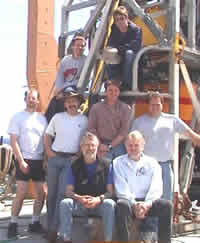| |
Teacher Logbook - NOAA Ship Ron Brown
| |

Don't lose your head around here, shrunken
heads experiment underway.

The ROPOS crew and Chief Scientist Bob Embley, before the last dive
of NeMO 2001. (l-r: front seated-Bob Holland, Bob Embley; second row-Ian
Murdock, Craig Elders, Keith Sheperd, Keith Tamburri; third row-Sebastian
Duran, Kim Wallace.)
|
|
Jeff Goodrich's Sealog:
Axial Volcano - ASHES Vent Field
July 30, 2001
Patience
is a virtue. The winds have dropped, the swells have lessened and ROPOS
is back in the water for it's last dive of the NeMO 2002 cruise, which
will be at ASHES vent field. In the NeMO tradition I'm conducting my own
deep-sea experiment. I've sent down a colored Styrofoam head attached
to the cage. Pressure at the Earth's surface is around one atmosphere
(14.6 pounds per square inch). As my head descends, it will be subjected
to one more atmosphere of pressure for every 10 meters it drops. By the
time it reaches Axial Volcano around 1500 meters depth, it will experience
150 atmospheres of pressure (about 2200 pounds per square inch). My Styrofoam
head should come up at about a quarter of its original volume. Talk about
a headache. I'll have the Tylenol ready. Check out the picture of a head
that's already returned from the deep. Chemist Susan Lang and a full-sized
Styrofoam head are used for scale. Notice how well Susan mimics the expression
of a shrunk head.
Fish, crabs,
octopus, worms, limpets, snails, clams, and all the other fauna living
near the vents at Axial must be able to stand the intense pressure depth.
In contrast, surface fish that contain air-filled swim bladders could
never withstand the pressure exerted on the deep-sea fauna. Their swimbladder
would collapse and kill the fish. Besides heat and corrosion from the
vents, the pressure at the bottom is important when deploying instruments.
The big yellow floats used to raise anchored moorings to the surface contain
3/4 inch thick glass that's rated to 6000 meters (9000 psi). ROPOS is
encased in a shell made of glass micro-balloons in an epoxy matrix. It's
extremely durable at depth and able to provide needed buoyancy. If the
vehicle were not built to withstand the pressure it would come up looking
something like Susan Lang's shrunken head. Definitely not large enough
to hold all the samples we hope to recover on our final dive at Axial.
|
|

